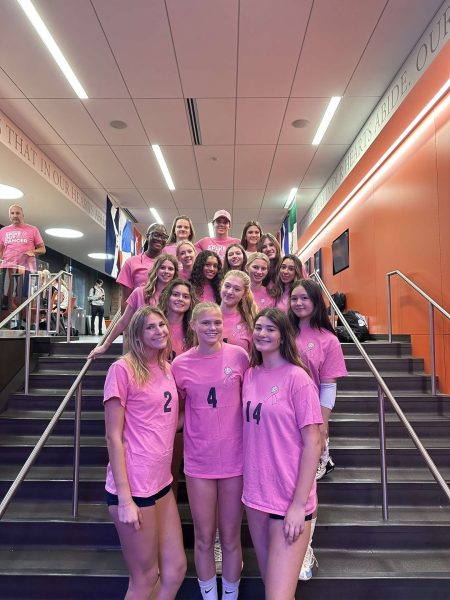The Lifer Complex
October 4, 2019
Every Latin student’s origin story is different–whether transferring here in the middle of high school, or being the most recent piece of a three-generation family legacy–and, ideally, this shouldn’t affect students’ experiences at the school. That said, sometimes the ideal differs from the actual, which begs the question: does the status of being a “lifer” at Latin carry any advantages?
As it turns out, the benefits of being a lifer–a term used to describe students who have attended Latin since junior kindergarten–may extend far beyond inclusion in the seniors’ traditional photoshoot on the lower school playground. Shreya Wojno, a sophomore, said that approaching the Latin community as a new freshman “felt like a maze,” and that it was like “trying to catch up in a class that you had missed for half a year.” She went on to explain that “since the grade is majority-lifers, the new kids are already kind of seen as ‘outsiders.’ It’s hard to be a new kid at Latin, to feel like you’re included socially, without having a connection to someone who has been there before.”
Balancing the pressure of being a new kid with undertaking Latin’s fairly heavy workload adds another level of difficulty. Junior Liam O’Keefe said, “I think it’s much harder for new kids in freshman year. Personally, I had to meet new people and balance the stresses of establishing myself socially at Latin with trying to manage academics. Once I settled in, though, I didn’t have too much trouble finding and maintaining a balance between the two.”
But while the social experience of a non-lifer likely varies from person to person, there’s one area in which the data is much more concrete: academics. Charlotte O’Toole, a junior and lifer whose mother and uncle went to Latin, offered some insight on this disparity: “Lifers definitely have an advantage academically. It’s much harder to get into the most challenging classes when you come in new to high school. Also, the coursework of middle school flows more easily into the academics of high school; the whole Latin curriculum makes sense chronologically.”
Charlotte’s claim seems to hold true. A quick Romannet investigation of Honors Geometry, the most advanced math class offered to Latin freshmen, reveals that 21 freshmen were placed into the class this year. All 21 attended the Latin middle school.
Lifers, though, vary in their connections to the Latin community. Olivia Katz, for example, is the most recent Latin student in a familial chain that includes her dad, uncle, and great-uncle. “I think the biggest effect of being a lifer,” she said, “is that I feel I have always been especially proud to go to Latin. It connects me to members of my family, and it’s a special thing that we all went there for 14 years. Singing the Alma Mater with my grandpa used to be so fun and exciting.”
Ultimately, the academic inequities that seem to exist between lifers and new freshmen may simply be due to Latin’s rather advanced middle school curriculum. Still, Charlotte called upon the administration to “develop a more thorough testing process” for gifted new students, who by no fault of their own are placed in a less challenging class than if they’d attended Latin’s middle school.
And while these academic disadvantages may be out of students’ hands, the alleged social challenges of coming to Latin in ninth grade are very much in the community’s control. While it’s important to keep in mind that the “lifer” status can be a special thing to students and their families, it’s nonetheless crucial for returning freshmen to make navigating Latin’s social “maze” a little bit easier.























































Lindley McCutcheon • Oct 9, 2019 at 4:20 pm
Great article! This definitely as interesting read, especially coming from a lifer perspective. However, I feel as though it’s not being a lifer that gives the advantages, but instead having gone through Latin’s middle school. I’d be interested to see how people who came in 5th, 6th, 7th, and 8th feel about lifers and the differences between their experiences. Regardless, thank you for the insightful read!
Robert Igbokwe • Oct 6, 2019 at 9:49 am
What an insightful, well-written article, Peter!! 🙂 I can relate far too well with my first few months at Latin feeling like a maze where everyone else knew where they were going. But with more incoming freshman coming in every year, I have hope that future non-lifers will immediately feel welcomed into Latin’s community!! 🙂
Zach McArthur • Oct 4, 2019 at 1:58 pm
Interesting article, Peter. I might push back on that new students are put into “less challenging” classes than lifers are their freshman year. Honors Algebra 2 is just as challenging as Honors Geometry, I believe. It’s just different material! Most kids coming in new to the upper school haven’t had Algebra 2 so for most of them – the majority of which are very strong students – it makes sense to strengthen their Algebra 2 skills (in an appropriately challenging setting) before tackling Geometry and Pre-Calculus. There are some that probably don’t need the extra algebra before Honors Geometry (*see some of your fellow editors) but they are few and far between.